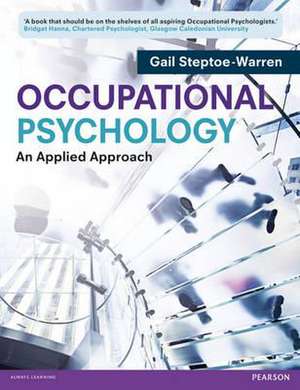Occupational Psychology
Autor Gail Steptoe-Warrenen Limba Engleză Paperback – 25 ian 2013
Preț: 417.07 lei
Preț vechi: 479.39 lei
-13% Nou
Puncte Express: 626
Preț estimativ în valută:
79.83€ • 86.74$ • 67.10£
79.83€ • 86.74$ • 67.10£
Carte disponibilă
Livrare economică 31 martie-14 aprilie
Livrare express 14-20 martie pentru 36.85 lei
Preluare comenzi: 021 569.72.76
Specificații
ISBN-13: 9780273734208
ISBN-10: 0273734202
Pagini: 344
Ilustrații: Illustrations (black and white)
Dimensiuni: 190 x 244 x 22 mm
Greutate: 0.67 kg
Editura: Pearson Education
ISBN-10: 0273734202
Pagini: 344
Ilustrații: Illustrations (black and white)
Dimensiuni: 190 x 244 x 22 mm
Greutate: 0.67 kg
Editura: Pearson Education
Notă biografică
Gail Steptoe-Warren is Senior Lecturer and Course Director in Occupational Psychology at Coventry University
Cuprins
- Preface
Acknowledgements
List of contributors
Guided tour
Publisher's acknowledgements
1. Introduction to occupational psychology
Learning outcomes
1.1 Introduction
1.2 Occupational psychology in the pre-First World War era
1.3 Occupational psychology in the First World War
1.4 Post-First World War and pre-Second World War
1.5 Occupational psychology in the Second World War
1.6 Occupational psychology in the 1940s to 1960s
1.7 Occupational psychology from the 1970s to the present
1.8 Challenges for occupational psychology in the 21st century
1.9 Conclusions
Short-answer questions
Further reading
2. Becoming a practitioner occupational psychologist and the consultancy cycle
Learning outcomes
2.1 Becoming a practitioner occupational psychologist
2.2 Consultancy
2.3 The consultancy cycle
2.4 Writing a business/consultancy report
2.5 Ethics
2.6 Conclusions
Short-answer questions
Websites
Further reading
3. Legislation applied to the workplace
Learning outcomes
3.1 Introduction
3.2 United Kingdom law
3.3 European law
3.4 Types of discrimination
3.5 Protected characteristics
3.6 Avoiding discrimination
3.7 Summary
Short-answer questions
Websites
Further information
4. Personnel selection and assessment
Learning outcomes
4.1 Introduction
4.2 Job analysis
4.3 Job description
4.4 Person specification
4.5 Job advertisements
4.6 Selection process
4.7 Fairness in selection
4.8 Decision-making
Multi-level impact of personnel selection and assessment
Legal context
Short-answer questions
Case study: Personnel selection and assessment
Further reading
5. Performance appraisal, career development, counselling and coaching
Learning outcomes
5.1 Introduction
5.2 Performance appraisal
5.3 Career development, counselling and coaching
Multi-level impact of performance appraisal and career development
Legal context
Short-answer questions
Case study: Performance appraisal and career development/counselling
Further reading
6. Well-being, stress and work--life balance
Learning outcomes
6.1 Introduction
6.2 Well-being
6.3 Stress at work
6.4 Causes of stress at work
6.5 Consequences of stress
6.6 Outcomes of stress reduction
6.7 Healthy workplace
Multi-level impact of stress
Legal context
Short-answer questions
Case study: Well-being, stress and work-life balance
Further information
7. Individual differences
Learning outcomes
7.1 Introduction
7.2 Personality
7.3 Intelligence
7.4 Values, individual beliefs and behaviour
Multi-level impact of individual differences
Legal context
Short-answer questions
Case study: Individual differences
Further reading
8. Training
Learning outcomes
8.1 Introduction
8.2 Models of training
